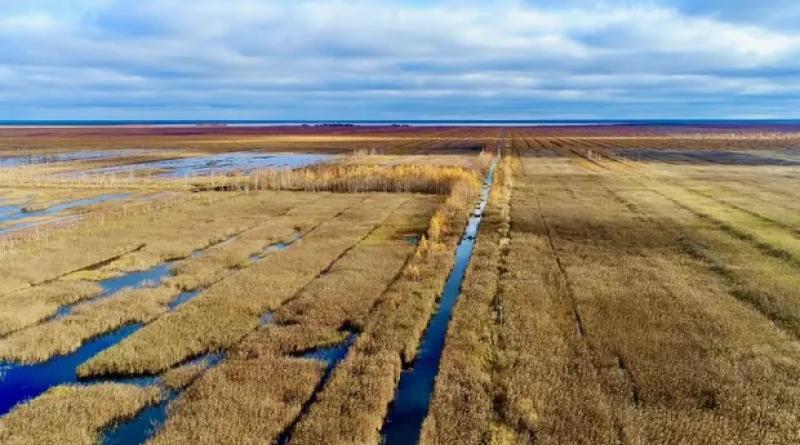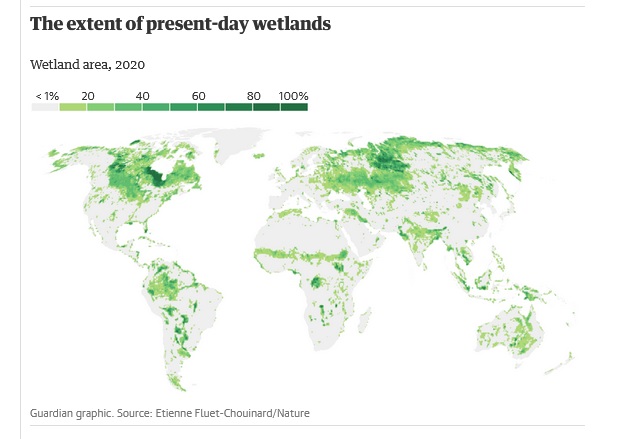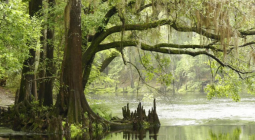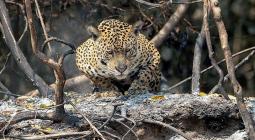Half the wetlands in Europe lost in past 300 years, researchers calculate

Assessment shows 20% global loss since 1700 – far less than thought – but Europe, US and China bear the brunt
Half the wetlands in Europe, continental US and China have been destroyed in the past 300 years, with some areas – including the UK, Ireland and Germany – losing more than 75%, new research shows. Globally, an area the size of India has disappeared.
Until now, it wasn’t known how many wetlands were left – previous estimates suggested between 28% and 87% had been destroyed since 1700. For the first time, researchers combined global historical records with maps of today’s wetlands to create a more accurate global picture, and found an estimated 20% of all wetlands destroyed. Europe, however, was the worst affected area, with Ireland losing more than 90% of its wetlands, Germany, Lithuania and Hungary more than 80% and the UK, the Netherlands and Italy more than 75%.
Despite some regions being very badly affected, the overall picture shows there is a lot left to save, say the researchers. “This is good news – it’s actually not too late to protect the majority of the wetlands in the world,” said lead author Etienne Fluet-Chouinard, from Stanford University.

For thousands of years, wetlands have been viewed by farmers as unproductive land, and drained. But in the past century the rate of destruction has increased rapidly. This, combined with the impact of the climate crisis, groundwater extraction, fires and rising sea levels has made wetlands among the most threatened ecosystems in the world, researchers write in the paper, published in Nature.
Previous estimates were probably wrong because scientists had a tendency to focus on regions where the loss was greatest (often those where most people live) and then extrapolate those numbers. But vast amounts of the planet’s peat bogs, mires and floodplains still exist in sparsely populated areas such as northern Canada, Siberia, the Congo and the Amazon. There are also lots of wetlands in Alaska, which brings down the US average loss to about 40%.
Globally, more than 60% of losses were driven by drainage for growing crops on uplands, followed by conversion to make paddy fields (18%) and the creation of urban areas (8%), according to the paper. Less than 1% was lost for peat extraction. Globally, peatlands store twice as much carbon as the world’s forests, so these are crucial ecosystems to preserve if climate targets are to be met.
Wetlands are important for biodiversity: up to 40% of the planet’s species live and breed in them. They also purify water, protect against flooding and improve the physical wellbeing of people in urban areas.
The destruction was fastest in the 1950s when government subsidies were given to farmers to drain land in North America, Europe and China to create fertile land for agriculture and forestry. Spain is the only European country with more than 50% of its wetlands intact.
Fluet-Chouinard said: “Now that we know the extent that’s been lost – and the benefits that are lost with the wetlands – we can make more educated and informed decisions about how we want to manage our landscapes.”

The research team looked at maps of wetlands, which are now mostly created using satellite imagery, and then worked their way back to older records, many from the 1900s, which have been digitised. In total, they looked at more than 3,000 land use and land drainage records. Data on how much land was drained before 1850 is patchy, which could mean the loss of wetlands is as high as 35%, the researchers say.
Working out the precise figure is important because it can help direct conservation efforts. The Convention on Biological Diversity agreement, signed at Cop15 in December, said 30% of land, sea and inland water needs to be protected, giving campaigners hope that freshwater ecosystems will no longer be relegated to a forgotten footnote.
“Wetlands are actually the superheroes of the natural world and can provide us with the ultimate nature-based solutions to tackle climate breakdown and its effects. We must do everything we can to not just halt this 20% loss but actually reverse it, and increase our wetland areas as a matter of urgency.”
Find more age of extinction coverage here, and follow biodiversity reporters Phoebe Weston and Patrick Greenfield on Twitter for all the latest news and features
COVER PHOTO: The Orshinski Mokh peatlands in the Tver province of Russia, where restoration efforts have been interrupted by the war in Ukraine





